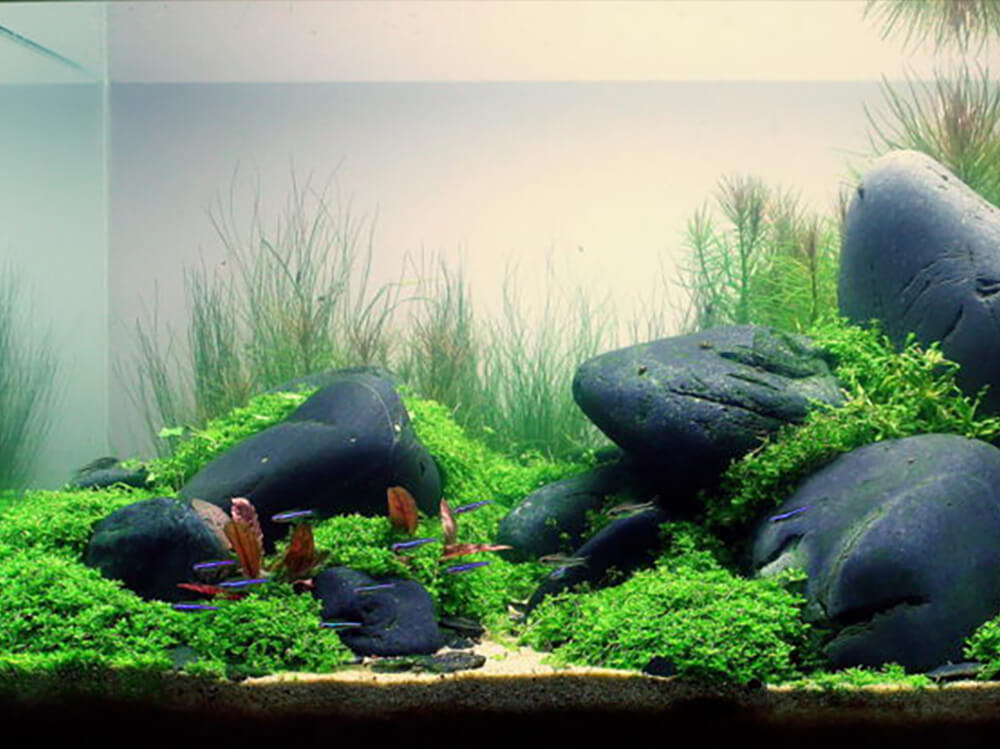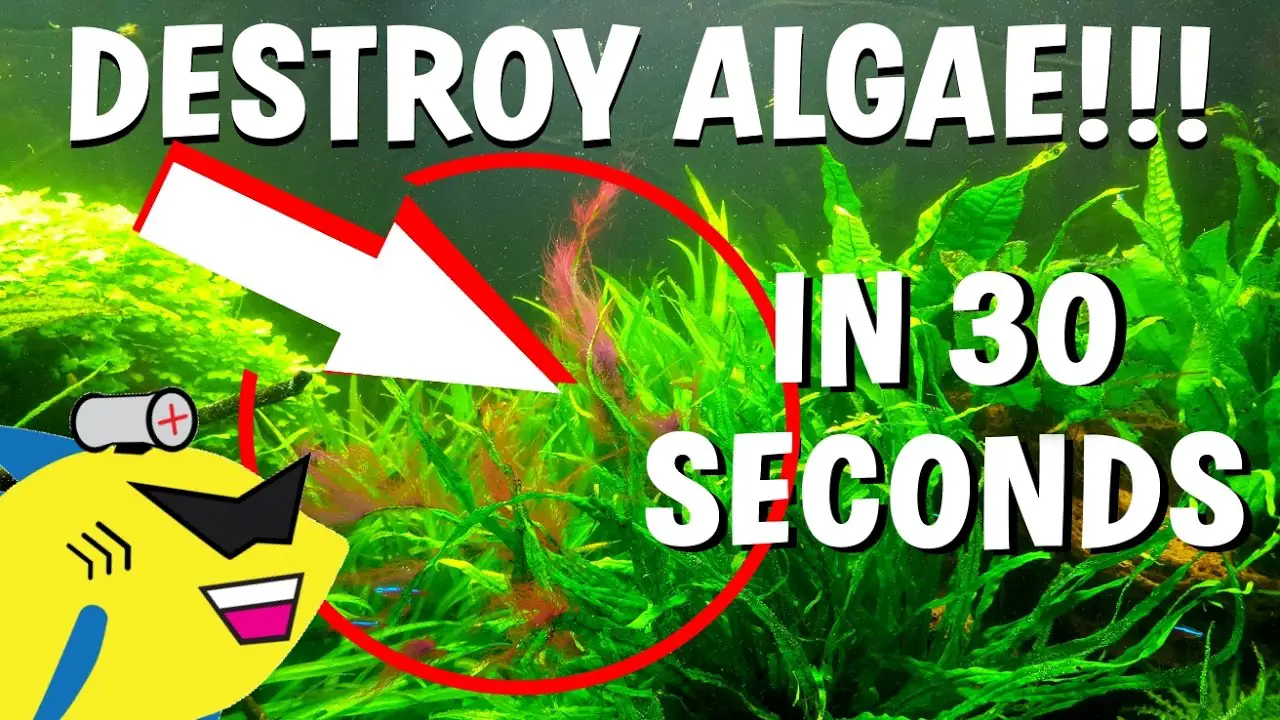Algae are a common problem in fish tanks, but there are several natural ways to get rid of them.
Firstly, it is important to reduce the light exposure in the tank as this encourages algae growth.
Secondly, clean and vacuum the gravel regularly, removing any dead plant material or food waste which can increase nutrient levels leading to increased algae growth.
Thirdly, avoid overfeeding your fish; excess nutrients will contribute to algae blooms.
Fourthly, add live plants that outcompete algae for resources such as nitrates and phosphates in the water column.
Lastly, introduce some bottom-dwelling species like plecos or Otocinclus catfish into your aquarium; these scavengers help keep down algal populations by consuming small amounts of it daily.
Following these steps should help you maintain a healthy balance and prevent further outbreaks of unwanted algae in your fish tank!
- Increase Water Flow: To get rid of algae in a fish tank, increase the water flow this will help to remove any debris from the environment that can feed algae growth and keep it from settling on surfaces within the tank.
- Clean Tank Regularly: A regular cleaning schedule for your tank is important to maintain good water quality and reduce algae growth. Remove uneaten food, dead plant material, and other debris regularly using a gravel vacuum or siphon hose to prevent them from breaking down into nutrients that could feed algae growth.
- Trim Plants: If you have live plants in your aquarium, trim them back frequently so they don’t take up all of the available light and nutrients in the tank which can cause an imbalance conducive to rapid algal blooms.
- Reduce Lighting Time: Another way to limit algal growth is by reducing lighting time in your aquarium since many types of algae thrive under bright light conditions with long photoperiods (the amount of daylight). Decrease lighting time gradually over several weeks until you reach about 10-12 hours per day depending on species needs if necessary.
What Kills Algae Naturally in Fish Tank?
Algae can be a nuisance in any fish tank, and many people turn to chemicals to rid their tanks of it.
However, there are several natural ways to kill algae that don’t involve harsh chemicals or expensive treatments.
One of the best methods is simply changing the water in your tank regularly this helps keep nitrate levels down, which helps stop algae from growing and spreading.
You can purchase certain species of fish such as Siamese Algae Eaters or Chinese Algae Eaters.
These types of fish will naturally eat algae from your tank walls and help keep it under control.
Another option is adding aquatic plants like Java Moss or Anacharis; these will consume excess nutrients in the water which prevents algae growth.
Finally, try increasing the amount of light on just one side of the aquarium.
By limiting sunlight exposure you can limit how much algae grows and spreads throughout your aquarium!
With a little bit of time and effort you should have no problem controlling all kinds of pesky algal growths in your fish tank!
How Do You Kill Algae Without Killing a Fish Tank?
One of the most common questions asked by fish tank owners is how to kill algae without harming their beloved aquatic creatures.
Algae growth in a fish tank can be caused by excess light, overfeeding, or poor filtration.
In order to safely get rid of it, you must first identify the cause and then follow some simple steps.
First, reduce the amount of light your tank receives each day as this will help slow down its growth.
Second, make sure you are not overfeeding your fish as this can lead to an excessive buildup of nutrients that may promote further algae blooms.
Check your filter and make sure it is clean and functioning properly so that debris does not accumulate in the tank and provide more food for the algae.
Finally, use products like algaecides or UV sterilizers specifically designed for aquariums to target just the unwanted population without harming any other species living in your watery environment!
Will Vinegar Kill Algae in Aquarium?
Vinegar is a natural cleaning agent that can be used to kill algae in aquariums.
It is a safe and non-toxic way to clean your tank without using harsh chemicals.
Vinegar works by breaking down the cell walls of the algae, which causes them to die off quickly.
To use vinegar, you should first remove any fish or other animals from the tank before adding it directly into the water.
You will want to use one cup of distilled white vinegar per five gallons of water in your aquarium.
After adding the vinegar, wait for 24 hours and then check on your tank again.
If there are still some patches of algae left, repeat this process until they are all gone.
Once done, make sure you thoroughly rinse out the tank with fresh water to remove any traces of vinegar from your aquarium as it could be harmful for both plants and fish if ingested or absorbed through their skin.
What Homemade Solution Kills Algae?
Homemade solutions can be a great way to combat algae in ponds and other water features.
Many natural ingredients, such as baking soda, vinegar, hydrogen peroxide and lemon juice have been known to work well against algae.
To make an effective solution for killing the algae in your pond or other water feature, you will need to mix one of the above ingredients with some warm water.
For example, if using baking soda add 1/2 cup of it into 2 gallons of warm water until it is dissolved completely.
Then pour the mixture directly onto any visible signs of algae growth in your pond or stream.
You may also want to use a garden sprayer for larger areas that are affected by the green nuisance.
If you prefer something more natural than chemicals then try adding barley straw bales or mats.
Which release hydrogen peroxide into the water naturally when submerged under it this works just as well without damaging fish or plants living nearby!

Credit: www.swelluk.com
Best Algae Remover for Aquarium
When it comes to maintaining a healthy aquarium, selecting the best algae remover is essential.
Algae can rapidly grow in an aquarium and can choke off plants, clog filters and pumps, and cause diseases in fish.
To keep your tank clean of algae, you should pick a reliable product that contains natural ingredients like minerals or enzymes.
That work to reduce the growth of algae without harming other aquatic life in your tank.
Look for products that are safe for use with all types of fish and plants so you can get rid of any existing algae while also preventing future outbreaks.
How to Get Rid of Algae on Rocks in Fish Tank?
One of the most effective ways to get rid of algae on rocks in your fish tank is through manual removal.
This involves taking out the rocks and scrubbing them with a brush or sponge to remove any visible algae growth.
You can use an aquarium-safe cleaning solution to help loosen and remove stubborn patches of algae.
Finally, be sure to rinse the rocks thoroughly before putting them back in your fish tank.
How to Remove Stubborn Algae from Fish Tank Glass?
One of the most common aquarium maintenance tasks is removing stubborn algae from fish tank glass.
To do this, you will need to use an algae scrubber or a magnetic cleaner specific for your aquarium size.
For heavy infestations, it may be necessary to clean the glass with a solution of vinegar and water (1 part vinegar to 10 parts water).
After scrubbing, be sure to rinse thoroughly with fresh tap water before returning the tank’s inhabitants back into the environment.
How to Get Rid of Green Algae in Fish Tank?
One way to get rid of green algae in a fish tank is by using an algaecide.
Algaecides are specially formulated chemicals that effectively target and kill algae without harming the other inhabitants of your aquarium.
When choosing an algaecide, make sure it is specifically designed for use with freshwater aquariums as some can be too harsh for fish or plants.
You should always follow the instructions provided on the product label and never exceed recommended dosages.
How to Get Rid of Brown Algae in Fish Tank?
Brown algae, also known as diatoms, are a common problem in aquariums.
There are some simple steps you can take to get rid of brown algae and keep your fish tank clean.
First, reduce the amount of light that reaches the aquarium by keeping curtains or blinds closed during peak sunlight hours.
Secondly, make sure your filter is working properly and replace it with a new one if needed.
Finally, use an algaecide specifically designed for brown algae to kill off any existing colonies and prevent future growth.
Following these tips should help you get rid of brown algae in your fish tank quickly and easily!
How to Stop Green Algae in Fish Tank?
Green algae can be a problem for aquariums, as it has the potential to rob fish of oxygen and become unsightly.
To prevent or stop green algae in your fish tank, reduce excessive light exposure and make sure that you are performing regular water changes.
Adding certain species of snails or shrimp to your tank can help keep the growth of algae under control.
What Causes Green Algae on Aquarium Glass?
Green algae is one of the most common problems faced by aquarium owners and can appear on glass as a slimy, green covering.
The main cause of this type of algae is an imbalance in the aquarium’s environment, caused by too much light, not enough water movement or filtration.
Excess nutrients from overfeeding fish or adding too many plants, and insufficient maintenance.
To treat it effectively, reduce the amount of light entering your tank and increase water flow with a filter.
Regularly clean any decorations or gravel to remove any nutrient buildup that might be feeding the algae.
Types of Algae in Aquarium
Algae is an important part of a healthy aquarium ecosystem and there are many types that can be found in the home aquarium.
Common types include green algae, brown algae, red algae, diatoms, and blue-green bacteria.
Green algae is typically the most common type seen in tanks because it’s easy to grow and provides food for other organisms like snails.
Brown and red algae are often the result of high nutrient levels or incorrect lighting conditions while diatoms thrive with increased water flow and light intensity.
Blue-green bacteria can also exist as free floating plankton or form slimy mats on rocks or surfaces when environmental conditions are right.
Conclusion
Getting rid of algae in a fish tank can be done naturally with simple and inexpensive methods.
Regular water changes, proper filtration and lighting, as well as adding natural aquarium plants will help to keep the water clean, clear and free from algae.
By creating an environment that is unfavorable for the growth of algae, you can make sure your tank stays healthy for both your fish and yourself.
